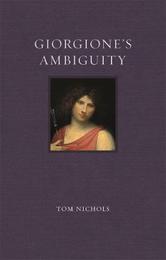
|
Giorgione's Ambiguity
Hardback
Main Details
| Title |
Giorgione's Ambiguity
|
| Authors and Contributors |
By (author) Tom Nichols
|
| Series | Renaissance Lives |
|---|
| Physical Properties |
| Format:Hardback | | Pages:288 | | Dimensions(mm): Height 216,Width 138 |
|
| Category/Genre | The arts -miscellaneous
Renaissance art
Individual artists and art monographs |
|---|
| ISBN/Barcode |
9781789142976
|
| Classifications | Dewey:759.5 |
|---|
| Audience | | Postgraduate, Research & Scholarly | |
|---|
| Illustrations |
60 illustrations, ? in colour
|
|
Publishing Details |
| Publisher |
Reaktion Books
|
| Imprint |
Reaktion Books
|
| Publication Date |
18 January 2021 |
| Publication Country |
United Kingdom
|
Description
The Venetian painter known as Giorgione or 'big George' died at a young age in the dreadful plague of 1510, possibly having painted fewer than twenty-five works. But many of these are among the most mysterious and alluring in the history of art. Paintings such as 'The Three Philosophers' and 'The Tempest' remain compellingly elusive, seeming to deny the viewer the possibility of interpreting their meaning. Tom Nichols argues that this visual elusiveness was essential to Giorgione's sensual approach and that ambiguity is the defining quality of his art. Through detailed discussions of all Giorgione's works, Nichols shows that by abandoning the more intellectual tendencies of much Renaissance art, Giorgione made the world and its meanings appear always more inscrutable.
Author Biography
Tom Nichols is a reader in art history at the University of Glasgow. His previous books include Tintoretto: Tradition and Identity and Titian and the End of the Venetian Renaissance, both also published by Reaktion.
Reviews"Nichols's book serves as an excellent, cerebral, and insightful essay on one of the most influential and enigmatic of Renaissance painters. Like one of Giorgione's own pictures, Nichols's analysis is lyrical, and thought-provoking; constantly drawn to the profound implications of its subject, yet never less than concise and accessible. The book is particularly welcome and timely. . . . Nichols is able to reserve his considerable intellectual energy for a revitalising and superbly informed discussion of the essence of Giorgione--both in terms of the elusive, enfolded meanings of his art, and in providing the reader with a navigable, clear-headed guide to a corpus of key works."--Philip Cottrell, assistant professor in art history, University College Dublin
|